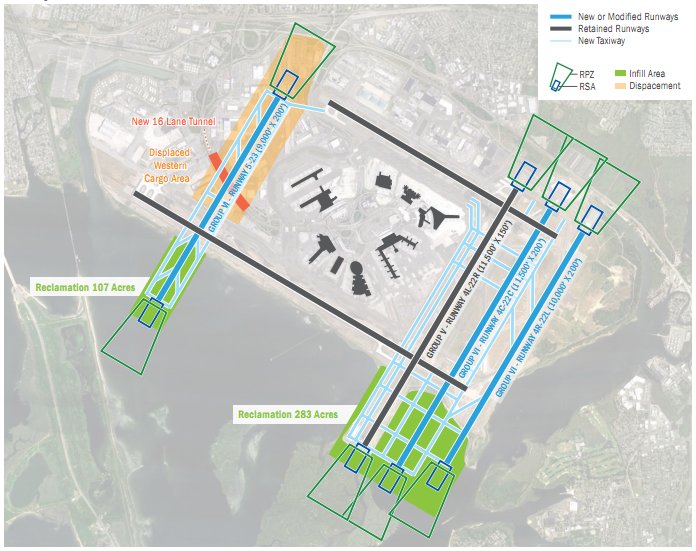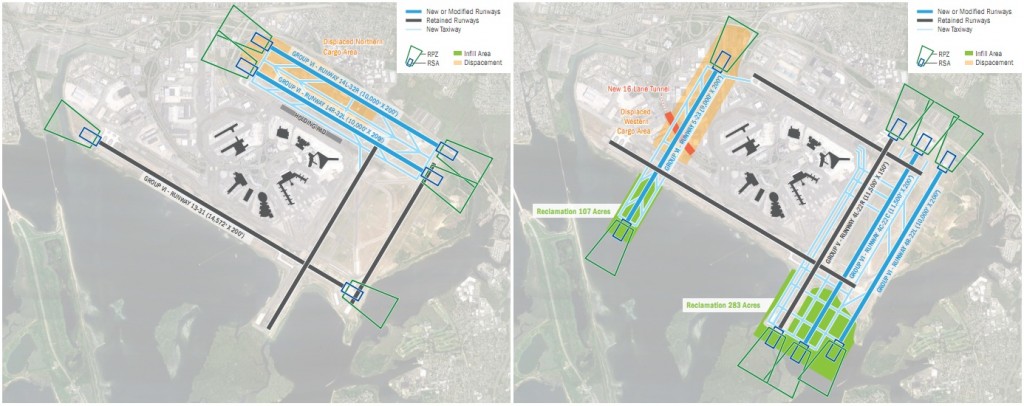John F. Kennedy Airport is one of the nation’s busiest airports and travellers face frequent delays. As air travel around New York increases, it could get worse. A new report on air traffic capacity contains, among several options to alleviate overcrowding, the possibility of expanding JFK Airport into Jamaica Bay. Local residents and conservation groups have reacted in an uproar.
At the beginning of the year, the Regional Plan Association (RPA)—an independent urban research and advocacy group—released a report on the growth of aviation traffic in New York City.
The report’s authors predict that passenger volume in New York will grow from 104 million passengers in 2010 to 150 million passengers in the 2030s. This growth, without improvements to the current aviation infrastructure, could cost billions of dollars in lost wages and business income. The report predicts that by 2030, as many as 125,000 jobs, $6 billion in wages and $16 billion in business sales would be lost yearly due to airport congestions and delays.
Among the possible solutions for accommodating increased commuter traffic is expanding JFK into Jamaica Bay. One proposal suggests an expansion of nearly 400 acres—almost two-thirds the size of LaGuardia Airport—while another would involve no reclamation of the bay.
After RPA released their report, a tide of criticism rose in the community that left some residents calling the RPA tools for the Port Authority.
On April 7, at the American Legion Hall on Crossbay Boulevard in Broad Channel, Dan Mundy of the Jamaica Bay Eco Watchers hosted a presentation to counter the RPA report.
Mundy opened the presentation by arguing that the central premise of the RPA report—that New York will have a significant rise in airline traffic—is based on a growth that would bring the city’s aviation to “a crippling halt.”
Congressman Anthony Weiner (D-Kew Gardens) who flew in from Washington D.C. and was running late for a flight back to Washington, spoke briefly during Mundy’s presentation and promised he would do everything in his power to stop expansion into the bay.
“I have made it very clear that while there is ability for the Secretary [of the Interior] to make minor changes to the map, this is not minor, this is major, I’m against this, and I’m not going to let it happen,” Weiner said.
One of the biggest complaints Mundy had with the RPA report was that previous reports about air traffic growth were always overestimated.
“It’s a doomsday prediction,” he said. “We went back 55 years and looked at all these reports. What we found was that the predictions were always overstated.”
A 1969 RPA report predicted that by the year 2000 there would be at least 250 million air passengers per year in the New York area—there were actually 90 million. Mundy said that by following historical data, an increase to between 115 and 125 million air passengers by 2030 could be predicted, rather than the 150 million predicted in the RPA report.
RPA Director of Transportation Richard Barone, one of the report’s authors, defended the current report and joked that he “wasn’t even born when [the 1969] report came out.”
“[The 1969] predictions were very optimistic, it was a period of very aggressive growth in air travel,” he said, adding that the old RPA reports used a six percent growth rate.
The recent report was based on a conservative, two percent growth rate, he said.
Barone said the RPA had attended the meeting to get input and hopes to return to the area and present updates.
“Obviously in the report we state that expanding into Jamaica Bay is huge deal,” Barone said. “We’re not opposed to making changes.”
Despite Barone’s concessions, and insistence that the RPA has no other agenda than presenting their analysis to “start a conversation,” the immediate response after he finished speaking was vitriolic. “I should take that as a direct insult to my intelligence,” said John, a local resident.
Don Riepe, Director of the American Littoral Society’s Northeast Chapter, pointed out that the bay has been reclaimed for development since New York City was founded. At one time, the bay was twice its current size, spreading out as salt marshes across Brooklyn and Queens. Today, the bay’s wildlife, including migrating hawks, peregrine falcons, osprey, herons and more than 100 types of finfish, compete for less and less livable space, Riepe said.
He noted that JFK already has problems with animals trying to coexist with planes. Last year, the city euthanized thousands of geese over fears the migrating birds would cause an incident like the forced Hudson River emergency landing. JFK now has a full time biologist on staff to deal with local wildlife.
“Just because you have an urban airport doesn’t mean you won’t have wildlife,” Riepe said.
Bradford H. Sewell, Senior Project Attorney for the Natural Resources Defense Council, explained that proposed changes would alter the flight paths, adding to noise pollution over the bay—disturbing the natural “soundscape” of the bay. He added that new flights would pass, at an elevation of 1,000 to 1,500 feet, directly over the Jamaica Bay visitor center. If the frequency of traffic doubles at the airport, flights could pass overhead every 30 seconds.
“I hope that we can double our efforts … because the impacts of this sort of expansion into Jamaica Bay would be unacceptable,” said Sewell, who has had prior experience in airport expansion battles.
In the RPA report, there are four proposals for the expansion of JFK. Three include reclaiming some of the bay. The report’s authors noted—based on NY Port Authority reports—that the area of expansion is a dead zone, depleted of oxygen as a result of dredging. Mundy, Riepe and Sewell all refute that claim.
Vinnie Calabro, a Jamaica Bay fisherman and charter boat captain, said the area the NY Port Authority considers a dead zone is teeming with wildlife, and is the site of several recent catches.
“We’ll be on the boat some days looking at the people on the tarmac reading the New York Times and we’ll catch another one of these big fish.” said Calabro. “They don’t realize what’s going on. They’re caught up in the headlines, but there are headlines right here in the bay. We have to speak out.”
One RPA proposal that does not include expansion of JFK into the bay, which Barone said was overlooked by Sewell, would require upgrading the airport’s air traffic control with NextGen capabilities. NextGen, being implemented by the Federal Aviation Administration over the next few years, includes Global Positioning Systems and operational and procedural changes.
The biggest hurdles JFK must overcome—be aided by NextGen—is reducing flight delays and optimizing capacity, said the report.
Despite the report’s findings, no one is planning an actual airport expansion so far.
Edward Knoesel, manager of the New York Port Authority’s Environmental Services Aviation Department, said that the RPA report was commissioned by the Port Authority, stressing that the organization has a responsibility to look into their facilities and plan for the future of commerce and travel in the tri-state area.
“The RPA is a long-standing, very respected organization,” he said. “They have produced a series of options for further study. … The Port Authority is not proposing to do any fill in Jamaica Bay.”
“We’re not proposing to do any expansion at any airport,” Knoesel added. “What were doing is taking a look at what the RPA proposed and what [the community says] and see what is feasible.”
by David J. Harvey


